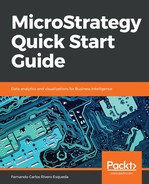To better understand Prompts, it is necessary to explain the different types. Their type will determine what objects can be used to build them and how and where to use them.
- Filter definition prompt:
- What is it for? To dynamically create a Filter based on the user response
- What is made of? A Filter definition on a Hierarchy, Attribute, Metric, or by directly picking Attribute elements
- Where can it be used? Since it is a dynamic Filter, it is possible to use it wherever a regular Filter can be used, such as Reports, other Filters, Custom Groups, and even within another Prompt (Object prompt, see later)
- Value prompt:
- What is it for? To input a value using a text box (or a date box or number box); then, this value can be used to complete another object's definition, such a Filter or a Metric
- What is made of? A text box, a number box, or a date box (free form input)
- Where can it be used? While creating a Filter or a Metric
- Level prompt:
- What is it for? To define the aggregation level (dimensionality) of a Metric
- What is made of? Attributes and Hierarchies
- Where can it be used? Within the Metric's dimensionality
- Object prompt:
- What is it for? To replace virtually any object in MicroStrategy
- What is made of? Attributes, Metrics, Templates, Facts, Filters, Reports, Functions and Operators, Custom Groups, and Consolidations
- Where can it be used? Mostly in Templates, but it can also be used on Filters, Metrics, Custom Groups, Subtotals, and even inside another Object Prompt (nested Prompts)
It is recommended to use the same type of object when creating an Object Prompt. Its usage will depend on what is inside it. For example, it won't be possible to place an Object Prompt inside a Template if it has Filters inside, because Filters can't be placed on Templates.
